Abstract
Factors determining the symptoms of breathlessness and fatigue in patients with congestive heart failure were investigated by comparing the response to slow and fast exercise. Symptom limited oxygen consumption (maximal); minute ventilation, mean pulmonary capillary wedge pressure; and arterial blood gases, pH, and lactate concentrations were measured during treadmill exercise using a slow protocol in 25 men (age 34-67 years) with congestive heart failure (New York Heart Association class II-III). Ten of these patients were also exercised according to a rapid protocol. Exercise was terminated by fatigue in 23/25 patients after the slow test and by breathlessness in all patients after the rapid test. Exercise capacity (maximal oxygen consumption and exercise duration) was not related to resting or exercise pulmonary capillary wedge pressure or the change in pulmonary capillary wedge pressure during exercise, nor was there any difference in pulmonary capillary wedge pressure at the end of exercise within individuals between the fast and slow tests. Minute ventilation was greater (51 vs 43 1/min), peak exercise lactate concentration higher (3.7 vs 2.2 mmol/l), and the change in pH from the resting state was greater (0.06 vs 0.02) during the rapid test than during the slow test. The sensation of breathlessness in congestive heart failure is not simply related to raised pulmonary capillary wedge pressure, but may in part be due to stimulation of peripheral chemoreceptors in response to metabolic acidosis.
Full text
PDF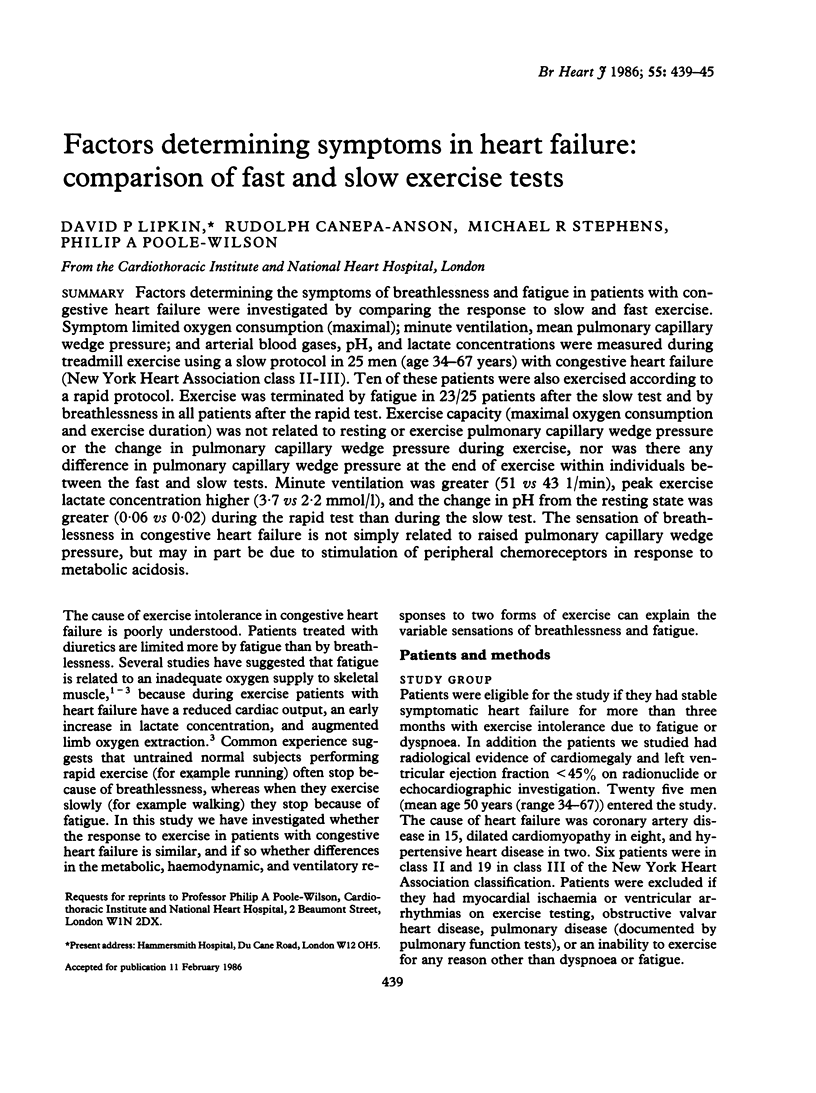
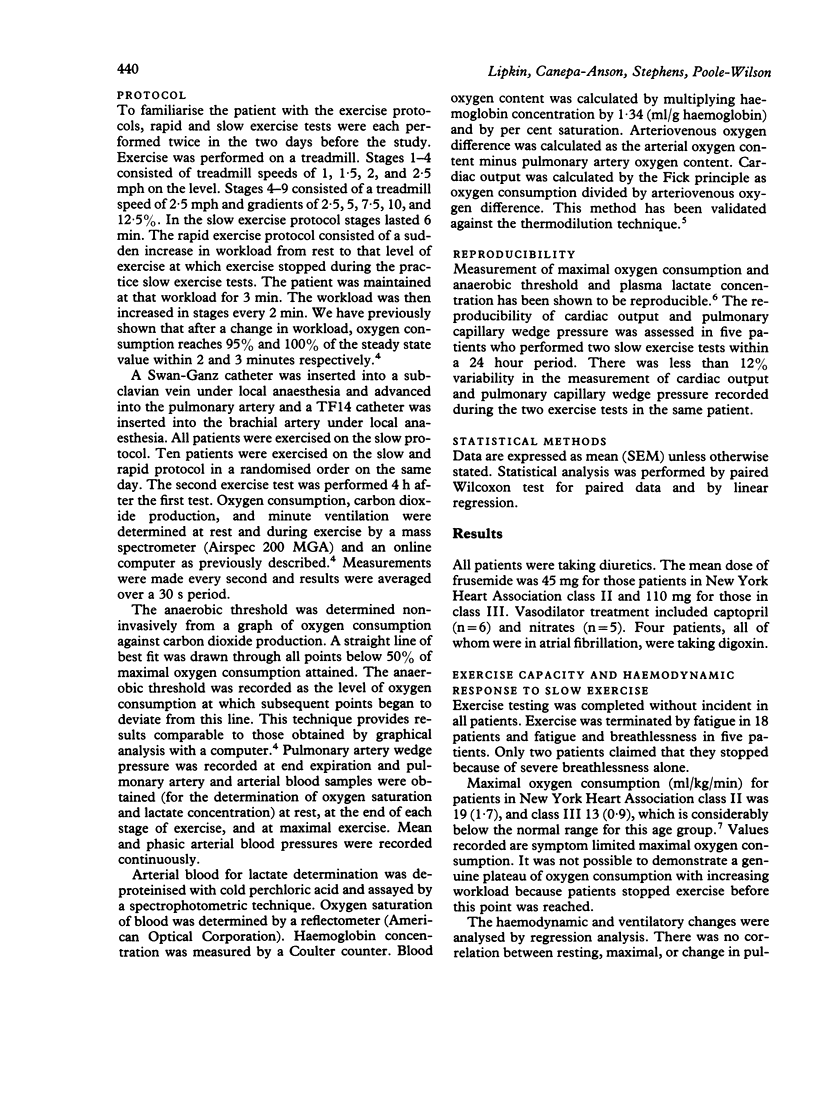
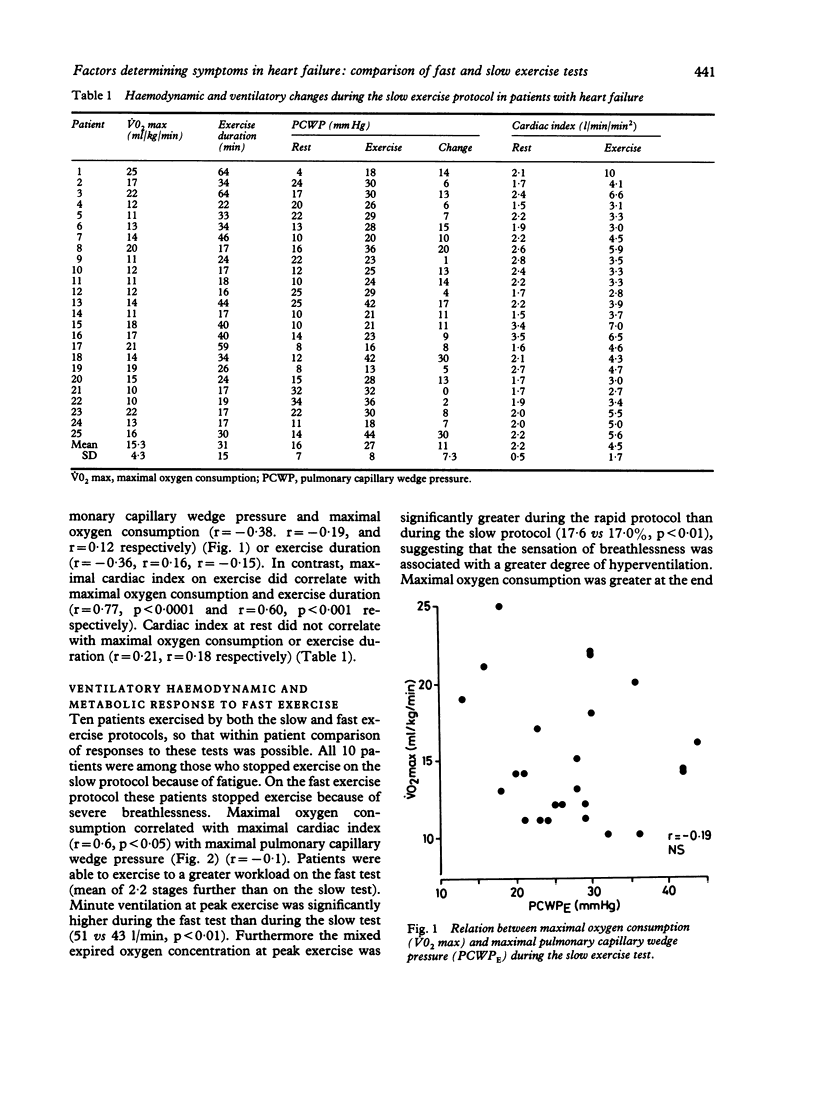
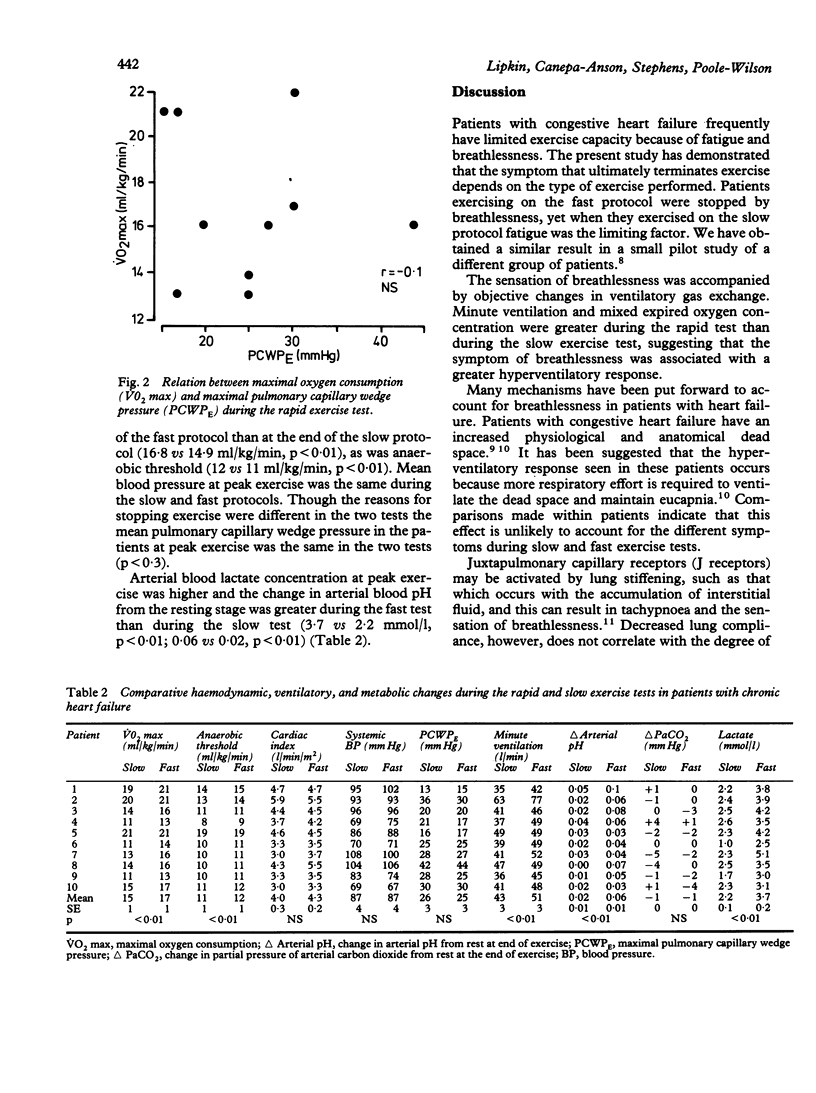
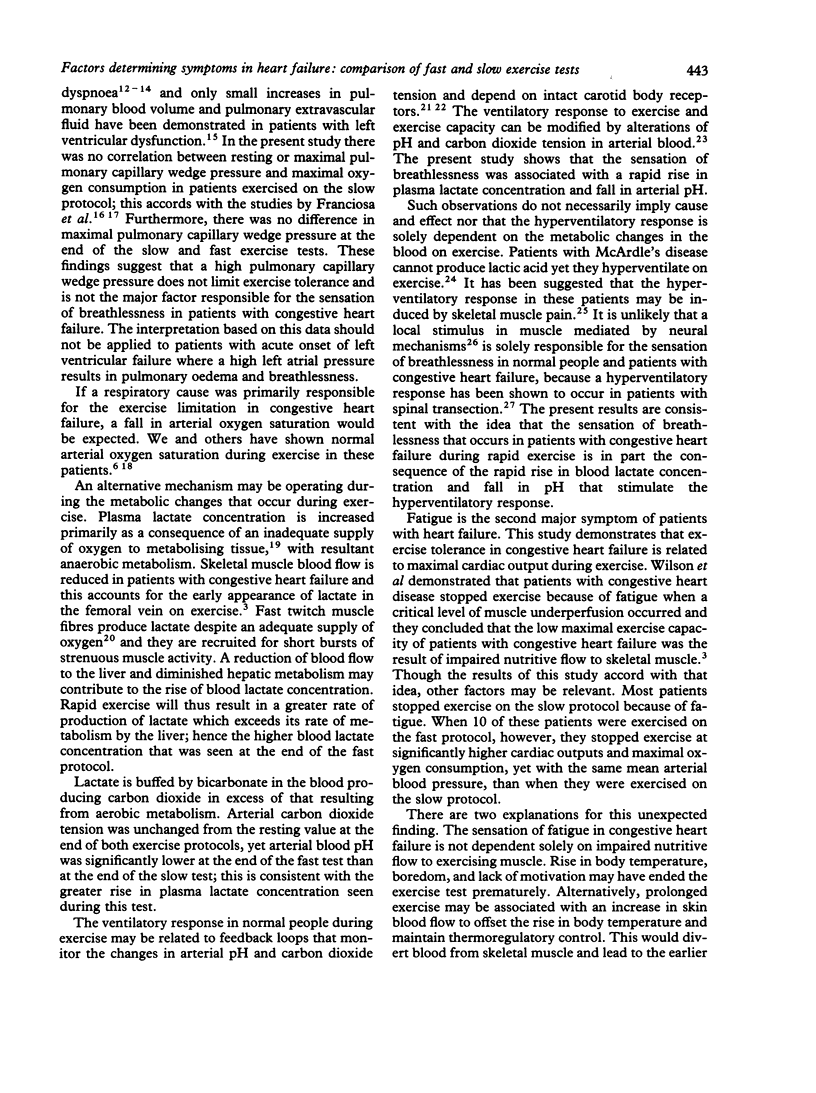
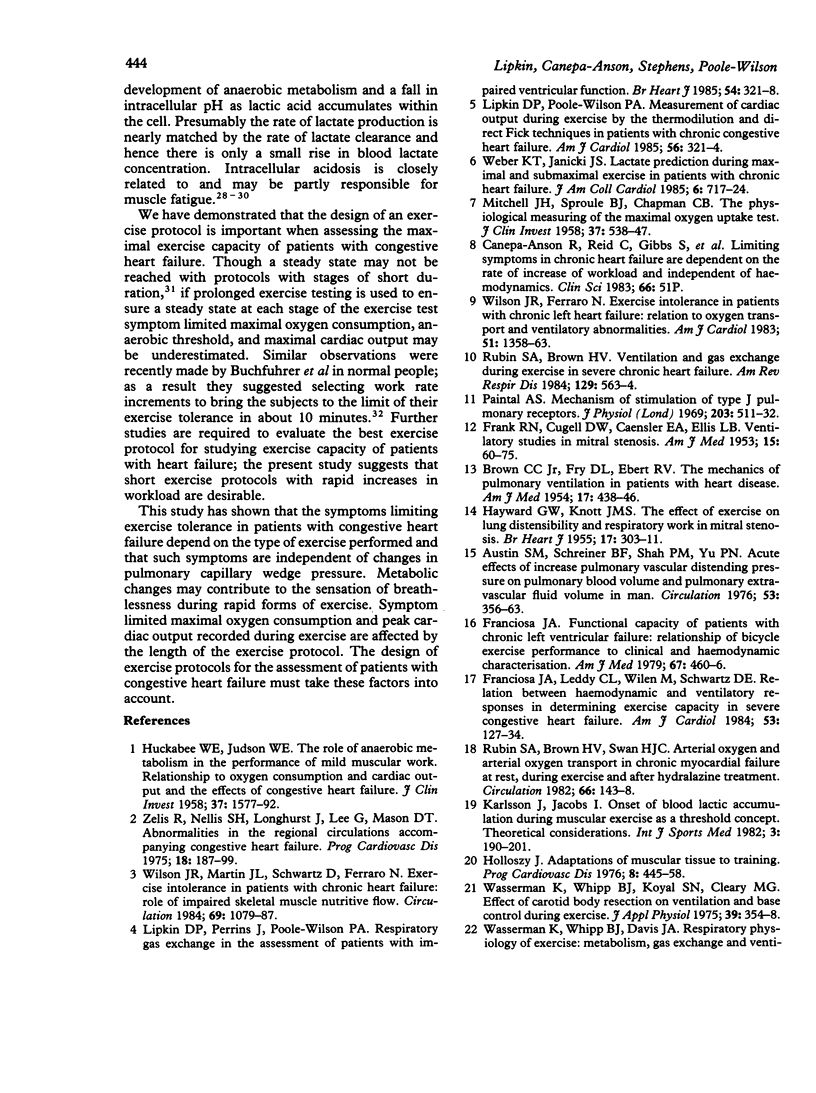
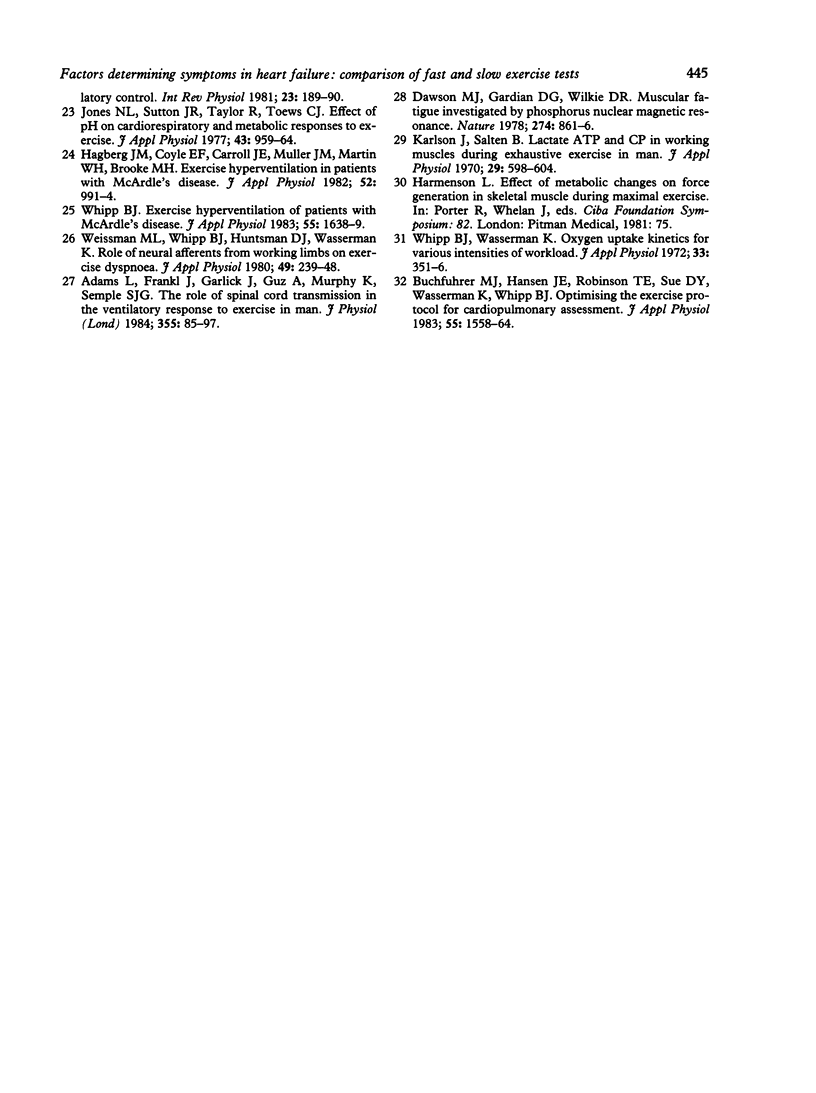
Selected References
These references are in PubMed. This may not be the complete list of references from this article.
- Adams L., Frankel H., Garlick J., Guz A., Murphy K., Semple S. J. The role of spinal cord transmission in the ventilatory response to exercise in man. J Physiol. 1984 Oct;355:85–97. doi: 10.1113/jphysiol.1984.sp015408. [DOI] [PMC free article] [PubMed] [Google Scholar]
- Austin S. M., Schreiner B. F., Shah P. M., Yu P. N. Acute effects of increase in pulmonary vascular distending pressures on pulmonary blood volume and pulmonary extravascular fluid volume in man. Circulation. 1976 Feb;53(2):356–363. doi: 10.1161/01.cir.53.2.356. [DOI] [PubMed] [Google Scholar]
- BROWN C. C., Jr, FRY D. L., EBERT R. V. The mechanics of pulmonary ventilation in patients with heart diseases. Am J Med. 1954 Oct;17(4):438–446. [PubMed] [Google Scholar]
- Buchfuhrer M. J., Hansen J. E., Robinson T. E., Sue D. Y., Wasserman K., Whipp B. J. Optimizing the exercise protocol for cardiopulmonary assessment. J Appl Physiol Respir Environ Exerc Physiol. 1983 Nov;55(5):1558–1564. doi: 10.1152/jappl.1983.55.5.1558. [DOI] [PubMed] [Google Scholar]
- Ceuppens J. L., Lacquet L. M., Mariën G., Demedts M., van den Eeckhout A., Stevens E. Alveolar T-cell subsets in pulmonary sarcoidosis. Correlation with disease activity and effect of steroid treatment. Am Rev Respir Dis. 1984 Apr;129(4):563–568. [PubMed] [Google Scholar]
- Dawson M. J., Gadian D. G., Wilkie D. R. Muscular fatigue investigated by phosphorus nuclear magnetic resonance. Nature. 1978 Aug 31;274(5674):861–866. doi: 10.1038/274861a0. [DOI] [PubMed] [Google Scholar]
- FRANK N. R., CUGELL D. W., GAENSLER E. A., ELLIS L. B. Ventilatory studies in mitral stenosis; a comparison with findings in primary pulmonary disease. Am J Med. 1953 Jul;15(1):60–76. doi: 10.1016/0002-9343(53)90055-2. [DOI] [PubMed] [Google Scholar]
- Franciosa J. A., Leddy C. L., Wilen M., Schwartz D. E. Relation between hemodynamic and ventilatory responses in determining exercise capacity in severe congestive heart failure. Am J Cardiol. 1984 Jan 1;53(1):127–134. doi: 10.1016/0002-9149(84)90696-9. [DOI] [PubMed] [Google Scholar]
- Franciosa J. A., Ziesche S., Wilen M. Functional capacity of patients with chronic left ventricular failure. Relationship of bicycle exercise performance to clinical and hemodynamic characterization. Am J Med. 1979 Sep;67(3):460–466. doi: 10.1016/0002-9343(79)90794-0. [DOI] [PubMed] [Google Scholar]
- HAYWARD G. W., KNOTT J. M. The effect of exercise on lung distensibility and respiratory work in mitral stenosis. Br Heart J. 1955 Jul;17(3):303–311. doi: 10.1136/hrt.17.3.303. [DOI] [PMC free article] [PubMed] [Google Scholar]
- HUCKABEE W. E., JUDSON W. E. The role of anaerobic metabolism in the performance of mild muscular work. I. Relationship to oxygen consumption and cardiac output, and the effect of congestive heart failure. J Clin Invest. 1958 Nov;37(11):1577–1592. doi: 10.1172/JCI103751. [DOI] [PMC free article] [PubMed] [Google Scholar]
- Hagberg J. M., Coyle E. F., Carroll J. E., Miller J. M., Martin W. H., Brooke M. H. Exercise hyperventilation in patients with McArdle's disease. J Appl Physiol Respir Environ Exerc Physiol. 1982 Apr;52(4):991–994. doi: 10.1152/jappl.1982.52.4.991. [DOI] [PubMed] [Google Scholar]
- Holloszy J. O. Adaptations of muscular tissue to training. Prog Cardiovasc Dis. 1976 May-Jun;18(6):445–458. doi: 10.1016/0033-0620(76)90011-6. [DOI] [PubMed] [Google Scholar]
- Jones N. L., Sutton J. R., Taylor R., Toews C. J. Effect of pH on cardiorespiratory and metabolic responses to exercise. J Appl Physiol Respir Environ Exerc Physiol. 1977 Dec;43(6):959–964. doi: 10.1152/jappl.1977.43.6.959. [DOI] [PubMed] [Google Scholar]
- Karlsson J., Jacobs I. Onset of blood lactage accumulation during muscular exercise as a threshold concept. I. Theoretical considerations. Int J Sports Med. 1982 Nov;3(4):190–201. doi: 10.1055/s-2008-1026087. [DOI] [PubMed] [Google Scholar]
- Lipkin D. P., Perrins J., Poole-Wilson P. A. Respiratory gas exchange in the assessment of patients with impaired ventricular function. Br Heart J. 1985 Sep;54(3):321–328. doi: 10.1136/hrt.54.3.321. [DOI] [PMC free article] [PubMed] [Google Scholar]
- Lipkin D. P., Poole-Wilson P. A. Measurement of cardiac output during exercise by the thermodilution and direct Fick techniques in patients with chronic congestive heart failure. Am J Cardiol. 1985 Aug 1;56(4):321–324. doi: 10.1016/0002-9149(85)90857-4. [DOI] [PubMed] [Google Scholar]
- MITCHELL J. H., SPROULE B. J., CHAPMAN C. B. The physiological meaning of the maximal oxygen intake test. J Clin Invest. 1958 Apr;37(4):538–547. doi: 10.1172/JCI103636. [DOI] [PMC free article] [PubMed] [Google Scholar]
- Paintal A. S. Mechanism of stimulation of type J pulmonary receptors. J Physiol. 1969 Aug;203(3):511–532. doi: 10.1113/jphysiol.1969.sp008877. [DOI] [PMC free article] [PubMed] [Google Scholar]
- Rubin S. A., Brown H. V., Swan H. J. Arterial oxygenation and arterial oxygen transport in chronic myocardial failure at rest, during exercise and after hydralazine treatment. Circulation. 1982 Jul;66(1):143–148. doi: 10.1161/01.cir.66.1.143. [DOI] [PubMed] [Google Scholar]
- Wasserman K., Whipp B. J., Koyal S. N., Cleary M. G. Effect of carotid body resection on ventilatory and acid-base control during exercise. J Appl Physiol. 1975 Sep;39(3):354–358. doi: 10.1152/jappl.1975.39.3.354. [DOI] [PubMed] [Google Scholar]
- Weber K. T., Janicki J. S. Lactate production during maximal and submaximal exercise in patients with chronic heart failure. J Am Coll Cardiol. 1985 Oct;6(4):717–724. doi: 10.1016/s0735-1097(85)80472-1. [DOI] [PubMed] [Google Scholar]
- Weissman M. L., Whipp B. J., Huntsman D. J., Wasserman K. Role of neural afferents from working limbs in exercise hyperpnea. J Appl Physiol Respir Environ Exerc Physiol. 1980 Aug;49(2):239–248. doi: 10.1152/jappl.1980.49.2.239. [DOI] [PubMed] [Google Scholar]
- Whipp B. J. Exercise hyperventilation in patients with McArdle's disease. J Appl Physiol Respir Environ Exerc Physiol. 1983 Nov;55(5):1638–1639. doi: 10.1152/jappl.1983.55.5.1638. [DOI] [PubMed] [Google Scholar]
- Whipp B. J., Wasserman K. Oxygen uptake kinetics for various intensities of constant-load work. J Appl Physiol. 1972 Sep;33(3):351–356. doi: 10.1152/jappl.1972.33.3.351. [DOI] [PubMed] [Google Scholar]
- Wilson J. R., Ferraro N. Exercise intolerance in patients with chronic left heart failure: relation to oxygen transport and ventilatory abnormalities. Am J Cardiol. 1983 May 1;51(8):1358–1363. doi: 10.1016/0002-9149(83)90312-0. [DOI] [PubMed] [Google Scholar]
- Wilson J. R., Martin J. L., Schwartz D., Ferraro N. Exercise intolerance in patients with chronic heart failure: role of impaired nutritive flow to skeletal muscle. Circulation. 1984 Jun;69(6):1079–1087. doi: 10.1161/01.cir.69.6.1079. [DOI] [PubMed] [Google Scholar]


